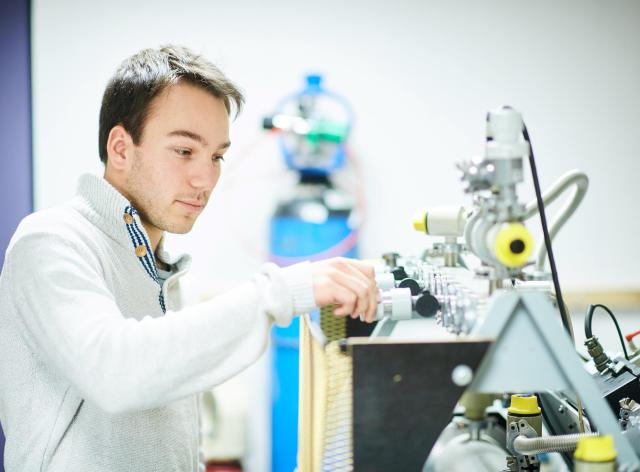Welcome to the Department of Physics!
How can we produce energy without exhausting the planet? What else can space exploration teach us? How can we treat patients more effectively with proton therapy? Artificial intelligence, friend or foe? And how is Schrödinger's cat doing?
You're asking yourself these kinds of questions, and you'd like to be able to answer them. You'd like to understand, know, solve, experiment, test, code, apply. You'd like to make a commitment to preserving the planet, to health, to society. You'd like to take up the challenge of corporate research, or you'd prefer to put your skills at the service of more fundamental knowledge. By joining the Department of Physics at the University of Namur, you will be satiated and we welcome you with enthusiasm.
Find out more about the Physics Department
Spotlight
News

Manipulating light to revolutionize quantum computing
Manipulating light to revolutionize quantum computing
Two researchers from the University of Namur's Department of Physics, Professor Michaël Lobet and his PhD student Adrien Debacq, are taking a close look at a subject that fascinates the scientific community : superradiance in media with a refractive index close to zero. In an article published this summer in Nature's prestigious journal Light: science & applications, in collaboration with Harvard University (USA), Michigan Technological University (MTU) and Sparrow Quantum, they contribute to the development of quantum computing.

For the past twenty years, a physical phenomenon has been attracting the attention of scientists over the world: superradiance in media with refractive indices close to zero. Among them, Michaël Lobet, professor at the Physics’ Department of UNamur, FNRS research associate and associate at the Harvard John A. Paulson School of Engineering and Applied Sciences (SEAS). “This is one of the major areas I've been studying for ten years now, and for which I was a post-doctoral fellow in Professor Eric Mazur's team at Harvard”, explains Michaël Lobet.
Superradiance, is a phenomenon that has been known for over half a century. It was theorized mathematically as early as 1954 by Robert Dicke, who showed that when elements such as atoms interact, they can synchronize to emit more powerful light. A bit like a choir singing in unison, the sound produced is much louder than each voice taken separately. But for doing this, the emitters must be very close to one another.
A index that changes everything
Scientists have discovered that one element can change everything: when the emitters are immersed in a material with a refractive index close to zero, rather than in vacuum, the position of the emitters is no longer an issue. The refractive index is a quantity that describes the behaviour of light in a material. In an ordinary material, light behaves a little like waves on the sea: it moves forward, forming crests and troughs that shift. But in a near-zero index medium, it's as if the sea becomes perfectly flat, with no waves, and starts moving up and down in a block. Everything moves in unison: the sea becomes uniform, and the wave stretches to infinity.
When the light field becomes more uniform, all the atoms find themselves optically close to each other, even if they are spatially distant. In other words, the "ambient" near-zero refractive index relaxes the strict distance between the atoms' positions, an essential condition for the entanglement of quantum particles. Quantum entanglement corresponds to correlations between particles, essential for the development of information and quantum computers.
From electrodynamics to quantum computing
This is where the promising contribution of a team of researchers from UNamur, Harvard and Michigan Technological University (MTU) comes in, supported by Dr. Larissa Vertchenko, from Danish quantum technology company Sparrow Quantum. Adrien Debacq, FNRS aspirant researcher at the Namur Institute of Structured Matter (NISM) and co-author of the paper, assisted by Harvard PhD student Olivia Mello and Dr Larissa Vertchenko, have together theoretically developed a photonic chip capable of radically improving the range of entanglement between transmitters, up to 17 times greater than in a vacuum. The emitters were made from nitrogen vacancy (NV) diamonds, structures well known in quantum optics.
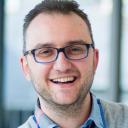
This is the first time that such a long range has been achieved using a compact system that can be easily implemented in photonic chips
“This paper shows how near-zero refractive index photonics can transition from classical electrodynamics to the quantum regime, since superradiance is intrinsically quantum.”, summarizes Eric Mazur, Professor at the Harvard School of Engineering and Applied Sciences, who has been at the forefront of these innovative materials for the past decade. Entanglement, another purely quantum property, enables the transfer of quantum information, a concept already raised by Einstein in the 1930s as part of his work on quantum mechanics. The present work is part of this continuation, and more generally of the “second quantum revolution”, which aims to build on the fundamental discoveries of Einstein and the other founding fathers of quantum mechanics.
Very concrete applications
This prospect confirms the nascent research in recent years to potentially revolutionary applications: more efficient lasers, more sensitive optical sensors and, above all, faster and ultra-secure telecommunication tools, thanks to quantum computers. Cybersecurity, for example, is about to be revolutionized by these discoveries, guaranteeing message security through physical laws rather than complex calculations.
Preserving the high degree of entanglement on chip over longer ranges may raise the possibility of multipartite entanglement involving many qubits useful for e.g., the construction of cluster states—important resource for universal one-way quantum computing—as well as large-area distributed quantum computing and quantum communication networks that may offer drastic increase on the computational and channel capacity.
Together with Dr. Seth Nelson, Güney has helped to study the dynamic response of the quantum system in the presence of a pump laser beam.
The challenge for future research is to transform this theoretical project, combining analytical models and numerical simulations, into concrete experimental realizations. The aim is to get a little closer to practical quantum systems, which fit into dimensions as small as the thickness of a human hair. Who knows, maybe one day we'll have a quantum computer in our pocket?
Acknowledgements
The researchers would like to thank the Department of Physics and the NISM Institute, the FNRS for funding the research mandates of Michaël Lobet and Adrien Debacq, and the PTCI technology platform, whose supercomputers made this study possible, as well as for funding in part by the United States Army Research Office under MURI grant (W911NF2420195).
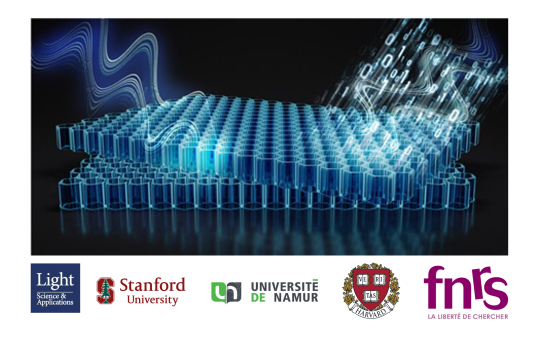
Let’s Twist (Light) Again: UNamur & Stanford bend beams in photonic crystals
Let’s Twist (Light) Again: UNamur & Stanford bend beams in photonic crystals
An international team of researchers has just published an article in the prestigious journal Light: Science & Applications (LSA) from the Nature group. The teams led by Professors Michaël Lobet and Alexandre Mayer (University of Namur) collaborated with the team led by Professor Shanhui Fan, one of the leading experts in the field, from the prestigious Stanford University in California (USA). The result: an article entitled ‘Twist-Induced Beam Steering and Blazing Effects in Photonic Crystal Devices’, or the study of beam deflection by twisting in photonic crystal devices. Come on, let's twist light again at UNamur!
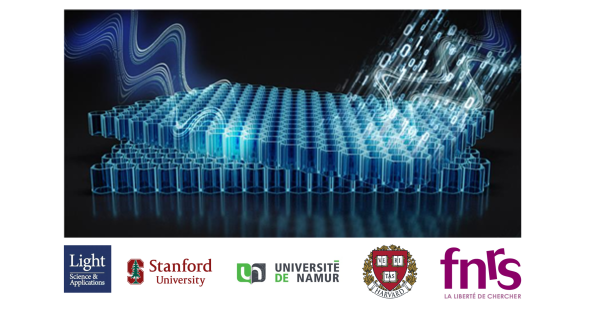
It all started with Nicolas Roy's trip to Stanford. Nicolas is a PhD student in the Department of Physics and a member of the NISM and NaXys Institutes. The purpose of the visit to Stanford was to develop expertise at UNamur on a new method of simulating twisted photonic crystals, recently published by the prestigious university. Following discussions during the stay at Stanford, avenues for collaboration emerged, notably that of continuing research related to one of their publications in order to try to make a device that allows the direction of the light beam to be manipulated as efficiently and compactly as possible. The gamble paid off, as the theoretical study predicts a device measuring 6 microns (the size of a hair)! What's more, it is very energy efficient. In practical terms, it could be used to track satellites, for example, without moving the transmitter or receiver, which is complicated in a photonic circuit. Another practical application is being studied for Meta, a company that wants to reduce the size of virtual reality headsets to a simple pair of glasses...
During his PhD, and based on a Stanford team publication entitled "Theory for Twisted Bilayer Photonic Crystal Slabs", Nicolas reproduced the simulation method and developed an analytical model of the numerical simulations. The use of these inexpensive simulations has made it possible to find the photonic structures most capable of deflecting light in a controlled manner. The analytical model, in turn, provides an explanation for what has been observed, and thus a better understanding of what's going on. In short, it opens up prospects for simpler fabrication of future devices.
"Computational intelligence, combining machine learning and optimization/automation by algorithms, makes it possible to save human time by performing very numerous and rapid calculations. By way of comparison, the calculations that were carried out without the use of this method developed by the Stanford research team took several days. We now have simulations lasting 1 hour. The machine learning methods I've developed now make it possible to carry them out in less than a second!"
A model, but for what?
The research teams collaborating on this study are working on twisted photonic crystals, i.e. two-dimensional materials formed, for example, from two superimposed and structured layers of silicon, and their interaction with light.
It is a bit like a sandwich made of two slices of bread that can be slid over each other.
Illustration caption: Schematic representation of the disoriented photonic device used to dynamically change the direction of light.
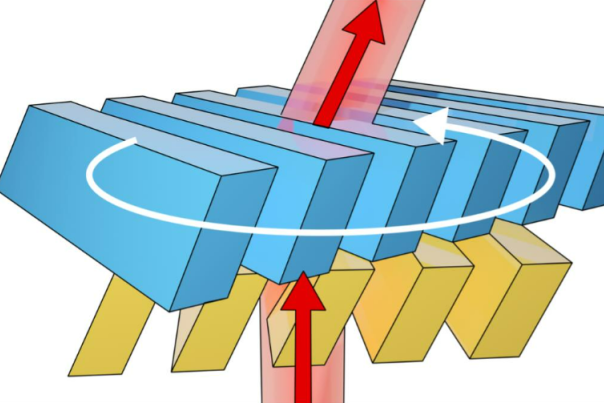
In designing an analytical model, Nicolas Roy also used a theory that has been known since the 1960s: lattice networks. A lattice network is a plane diffraction network with a sawtooth profile. In concrete terms, it resembles the roofs of old factories. The novelty he brought to this concept is that it allows us to understand the mechanism that controls the angle of the light beam's exit thanks to the twist between the two layers. In doing so, he identified that the system acted similarly to a lattice grating. The team, using meta-models, was able to concentrate the light in a very specific direction with 90% efficiency.
Mastering light
What is the purpose of this type of twisted structure? To control light and ultimately create systems that can slow it down or even stop it.

It's a remarkable feat for this speedster, light, which travels at over 300,000 km/s! It is the fastest speed that can be reached in the universe. Slowing it down is therefore no easy task. In this type of disoriented structure, light is trapped but its state is preserved: it is put ‘on pause’, so to speak. In practical terms, we can imagine improving the characteristics of lasers or the performance of quantum computers. One important application would be to create optical memories, which would allow light bits to be stored without being destroyed and released at will. Or at least slow them down long enough to perform the mathematical operations necessary for all-optical computing. Another application is to take advantage of the slowing down of light to enhance light-matter interactions. This can be used to increase the efficiency of chemical reactions in photocatalysis, for example. These photocatalytic reactions are useful for water treatment or air treatment, for example, subjects on which Professors Olivier Deparis and Bao-Lian Su are working at the NISM institute.
.
This twist technique therefore opens up many unexplored possibilities in photonics by adding a degree of control over light. The researchers are continuing their work in this area, continuing their fruitful collaboration with Professor Fan's team, Stanford University.
It looks like there's no end in sight to the twisting at the University of Namur!
The research teams involved
The Belgian team
- Professor Michael Lobet (UNamur, Harvard University)
- Professor Alexandre Mayer (UNamur)
- Dr Nicolas Roy (UNamur)
The American team
- Professor Shanhui Fan (Stanford University)
- Dr Beicheng Lou
Thanks
The researchers thank UNamur, and more specifically the Department of Physics and the NISM Institute for funding Nicolas Roy's trip, the Institut naXys for its support in this project, the PTCI technology platform, whose supercomputers made this study possible, as well as the FNRS for funding the research mandates of Michaël Lobet and Alexandre Mayer.
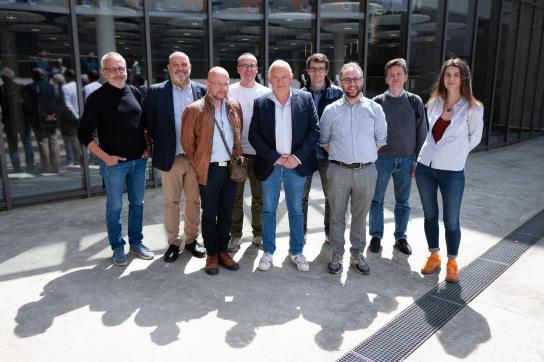
The Department of Physics welcomes a delegation from CERN
The Department of Physics welcomes a delegation from CERN
In May 2025, the Department of Physics welcomed two special visitors: Serge Mathot and François Briard from Namur, both alumni of UNamur and members of CERN. Several activities were on the program, ranging from a visit to the particle accelerator, to science popularization and thematic seminars, particularly in heritage sciences. The aim? To identify areas or activities in which UNamur and CERN could strengthen their collaboration.
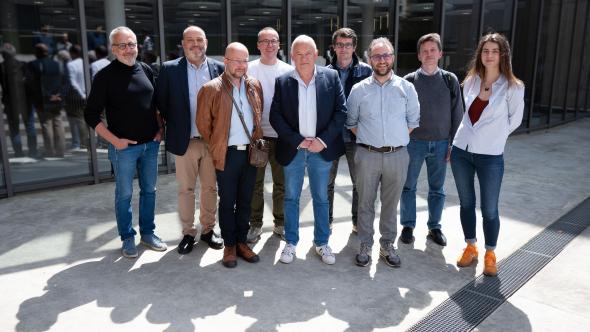
In the picture, from left to right: (top) Pierre Louette, Director of the Physics Department; François Briard, Head of the Science Portal Group (CERN); Julien Colaux, IBA specialist, physics researcher; Boris Hespeels, biology researcher; Alexandre Mayer, physics researcher; Anne-Catherine Heuskin, physics and biophysics researcher. (bottom) André Füzfa, astrophysicist and mathematics researcher; Serge Mathot, Applied Physicist (CERN) and Michaël Lobet, physics researcher.
The love affair between CERN and UNamur goes back a long way. CERN's accelerator complex and experimental program are very different and much larger than those of UNamur's Physics Department, but the fields in which the two institutions work have much in common.
In addition, both guests have a personal history with UNamur. The Physics Department was pleased to welcome Serge Mathot, Referent Applied Physicist (CERN) and alumni of the UNamur Physics Department (1992), as well as François Briard, Group Leader Science Portal (CERN), and alumni of the UNamur Faculty of Computer Science (1994).
The activities began with a meeting between the guests, Rector Annick Castiaux, Vice-Rector for Research Carine Michiels, Physics Department Director Pierre Louette and several other members of the Physics and Biology Department. After a general presentation of the University, the participants pointed out the missions shared by both institutions: research and the transfer of technology and knowledge, service to society, scientific popularization and education and training.
.
Focus on meetings
Physics lunch - CERN presentation
The physics lunch is the monthly meeting between students and members of the physics department and a professional, alumni or not, coming to explain his or her background and what he or she does on a daily basis as a physicist.
During this meeting, attended by around 80 people, François Briard and Serge Mathot presented CERN, the world's largest laboratory for particle physics. CERN's mission is to understand the most elementary particles and the laws of our universe.
At the end of the seminar, the students came away with stars in their eyes. Indeed, opportunities for internships or even first jobs at CERN are possible for physicists but also in many other fields.
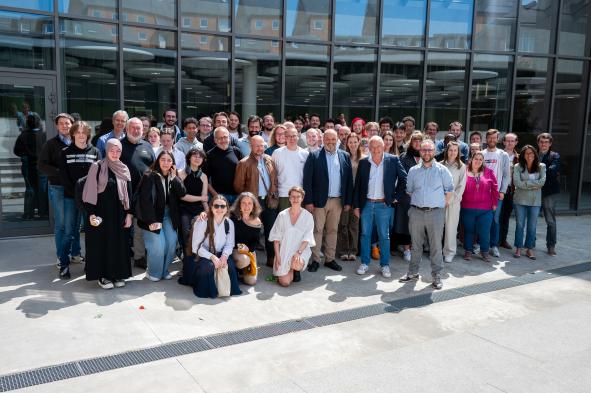
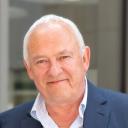
Your physics training at UNamur is your best ticket to a job at CERN. It's more than just a degree in particle physics!
Some internship programs at CERN are particularly well suited to the needs of young Belgian students.
The vast majority of physicists working with CERN (over 13,000) are in fact sent to CERN for varying periods of time by their employing national research institutes. CERN offers an exceptional opportunity to develop international experience under excellent conditions, in an environment that is unique in the world! What an inspiration for our young students!
Visit of the ALTAÏS and SIAM facilities
Capable of generating ion beams consisting of any stable element with energies of up to 16 Mega electron-Volt (MeV), the ALTAÏS particle accelerator is used in various fields of fundamental and applied research, notably through industrial partnerships. CERN's largest current linear accelerator can produce particle beams of up to 160 MeV.
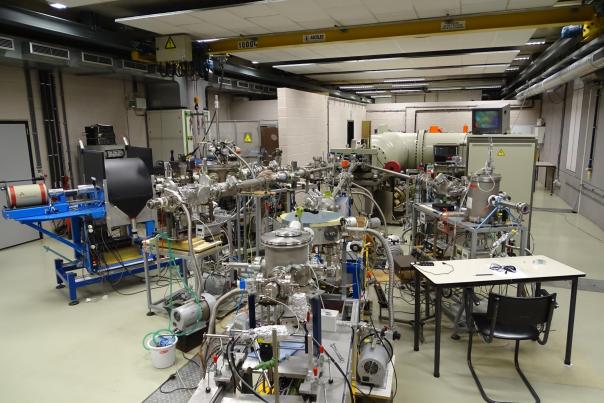
Meeting with members of the ARC PHOENIX project, complemented by a heritage science seminar given by Serge Mathot.
The projet d'Action Recherche Concertée (ARC) PHOENIX aims to renew our understanding of medieval parchments and ancient coins. Artificial intelligence will be exploited to analyze the data generated by material characterization.
This joint study between the Department of Physics and the Namur Institute of Structured Matter (NISM) and the Department of History and the Institut Patrimoines, Transmissions, Héritages (PaTHs) will address questions relating to the production chain and use of these objects and materials in past societies.
At the same time, Serge Mathot presented a seminar in heritage science attended by some 50 people. In particular, he presented his research and the brand-new ELISA accelerator: a miniaturized gas pedal capable of delivering a 2 MeV proton beam used to perform real measurements at the Science Portal.
Meeting on science popularization
Having the opportunity to exchange views with François Briard, Group Leader of the CERN Science Portal is a rare opportunity. Comparing outreach activities has opened up new avenues, discovering and sharing approaches, assessing what works and what doesn't, depending on the target audience. A highly satisfying enrichment for the members present from Confluent des Savoirs (CDS), the University of Namur's research outreach and dissemination service.
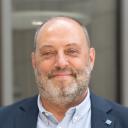
The CERN Science Portal is a place where you can explore CERN and science through authentic and innovative experiences: immersive multimedia exhibitions, hands-on lab workshops, science shows, events combining science and culture, prototyping workshops on the theme of innovation, tours of CERN sites, all accompanied by CERN staff.
BD Physix - Energy
Teachers André Füzfa and Michaël Lobet were able to present the comic strip project created with author Jean-Marc Dubois.
The theme? Energy!
What could be more natural than to talk about it with François Briard, chief popularizer at CERN, who is interested in this popularization project in a medium accessible to people aged 7 to 77!

Meeting on the theme of biophysics
Professor Anne-Catherine Heuskin and Dr. Boris Hespeels are currently working on the BEBLOB project, a Belspo project with ESA support, as part of the UNIVERSEH (European Space University for Earth and Humanity) alliance. They are particularly interested in its astonishing ability to withstand high doses of radiation.
Anne-Catherine Heuskin also works in radiobiology. Particles are used to irradiate cancerous cells in order to destroy their genetic material and prevent them from proliferating: this is the basis of radiotherapy and proton therapy.
Meeting with FaSEF regarding teacher training opportunities.
The meeting confirmed the willingness of FaSEF and UNamur to get involved in coordinating the Belgian National Teacher Programme in French-speaking Belgium, which CERN intends to relaunch in 2026. Consideration was also given to other avenues for teacher training, such as CERN's forthcoming involvement in the "Salle des Pros", the training venue for the various players involved in teacher training at UNamur.
.A visit to TRAKK
The TRAKK is Namur's creative hub supported by 3 complementary partners in the field: BEP, KIKK, and UNamur. In addition to the venue, François Briard was able to visit the ProtoLab , which bridges the gap between ideas and industry by being a decentralized research and development hub accessible to SMEs and project leaders by offering advanced support in prototyping products or services.
Guests at CERN
François Briard - CERN Science Portal Group Leader, UNamur alumni 1994
Specialities:
- Information systems, administrative applications and databases (Oracle)
- Communications for the general public
- Visitor reception logistics
- Event organization for up to 80,000 participants.
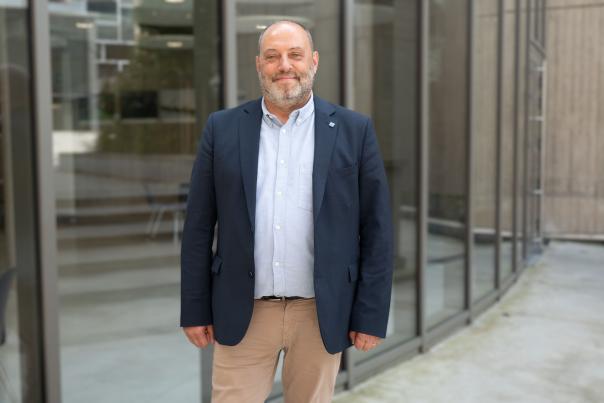
Graduating in law and information technology management (DGTIC) in 1994 after his bachelor's and master's degrees in computer science in 1993, François Briard works at CERN, the European Organization for Nuclear Research in Geneva, the world's largest particle physics laboratory.
During his school career, which was 100% at UNamur, he was vice-president of the Régionale namuroise and student delegate during his years as a candidate in economic and social sciences, computer science option.
Thanks to the multidisciplinary training provided at UNamur, he was able to seize several opportunities to redirect his career at CERN, where he was an information systems engineer from 1994 and then, from 2014, redirected his career until he became Group Leader of the Science Portal, which is CERN's general public communications center.
Serge Mathot - Referent Applied Physicist at CERN, UNamur alumni 1992
His specialties
- Ion Beam Analysis (IBA)
- Metallurgy, vacuum brazing
- Radio-Frequency Quadrupole (RFQ) linacs, ion sources

Serge Mathot obtained his doctorate in applied sciences from UNamur in 1992, following his bachelor's degree in physical sciences in 1985.
He then carried out a post-doctorate at the Joint Research Center (EU science hub) in Geel, which aims to bring together multidisciplinary skills to develop new measurement methods and tools such as reference materials.
He perfected his expertise in physical metallurgy before joining CERN in 1995 as a Referent Applied Physicist. He has worked on numerous research projects (CLOUD, MACHINA, ELISA...) and developed numerous parts for the manufacture of CERN's gas pedals.
It's a great pleasure to meet him.CERN
CERN, the European Organization for Nuclear Research, is one of the world's largest and most prestigious scientific laboratories. Its vocation is fundamental physics, the discovery of the constituents and laws of the Universe. It uses highly complex scientific instruments to probe the ultimate constituents of matter: the fundamental particles. By studying what happens when these particles collide, physicists understand the laws of Nature.
The instruments used at CERN are particle gas pedals and detectors. Gas pedals carry beams of particles at high energies to collide with other beams or fixed targets. Detectors observe and record the results of these collisions.
Founded in 1954, CERN is located on either side of the French-Swiss border, near Geneva. It was one of the first organizations on a European scale and today has 25 member states, including Belgium.
Physics programs at UNamur
From the infinitely small to the infinitely large, from elementary particles to galaxies, are you thirsty to understand the whys and wherefores of the natural phenomena you observe? Physics answers all your questions.
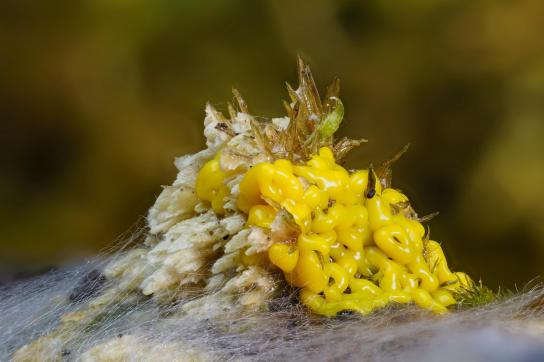
UNamur and the blob on board the International Space Station with Belgian astronaut Raphaël Liegéois
UNamur and the blob on board the International Space Station with Belgian astronaut Raphaël Liegéois
The three Belgian scientific experiments selected to be carried out on board the International Space Station (ISS) during astronaut Raphaël Liégeois' mission in 2026 have just been unveiled by the Federal Science Policy Public Service (Belspo). One of them is carried by a team from UNamur for an experiment at the crossroads of biology and physics aimed at analyzing the resistance of the "blob", an atypical unicellular organism.
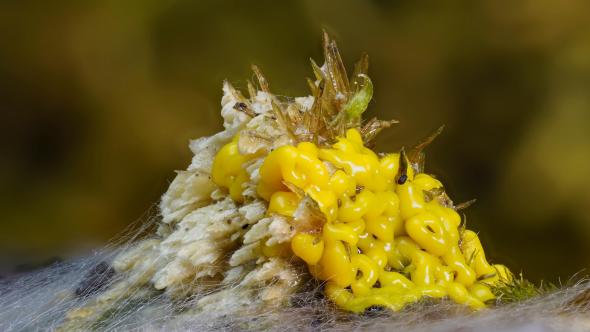
The three scientific experiments were selected from 29 projects for "their scientific value, technical feasibility and budgetary compatibility", states the public service of Federal Science Policy (Belspo).
Historically, Belgium has built up notable expertise and influence within the European Space Agency (ESA). Today, UNamur finds itself at the heart of an experiment that will be deployed during Belgian astronaut Raphaël Liegéois's stay aboard the ISS in 2026. The BeBlob project, conducted at the interface of biology and physics, aims to study Physarum polycephalum, commonly known as a "blob".
The amazing properties of the blob
This atypical unicellular organism, belonging to neither plants, fungi nor animals, fascinates scientists and the general public alike. "Although lacking a nervous system, the blob is capable of solving complex problems, such as finding the shortest path through a maze, and learning from its environment," explains Boris Hespeels.
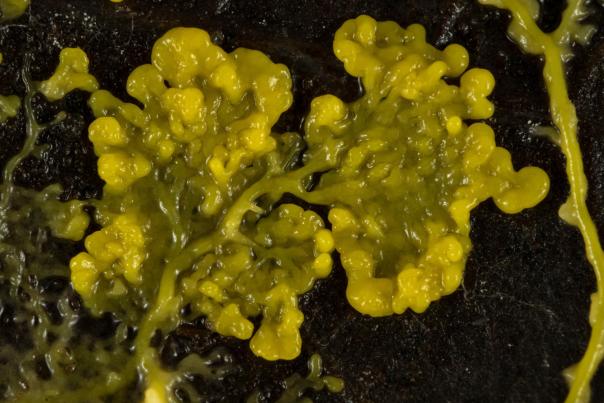
Boris Hespeels is a researcher at the ILEE Institute and the Beblob project leader alongside Anne-Catherine Heuskin, a researcher at the Narilis Institute. "We're also interested in its amazing ability to dry out completely and survive extreme stresses, including the vacuum of space, extreme temperatures or even high doses of radiation causing massive DNA damage," the two Namur researchers continue.
Development of a miniaturized vessel for the blob
Building on their experience gained on previous ISS missions with other biological models, UNamur teams have developed a new miniaturized "vessel" for carrying different blob samples. In orbit, the astronaut will rehydrate the samples, which will then have to adapt to their new environment. The objectives are twofold: firstly, to assess the effects of the orbital environment on blob metabolism; secondly, to study DNA repair in samples previously irradiated on Earth by massive doses. Scientists will analyze how this organism repairs its genome in microgravity, and determine whether this process is altered by spaceflight.
Implications and potential applications
This work should make it possible to identify key players in cell protection and repair under extreme conditions. Combined with the many experiments carried out at UNamur, they could ultimately lead to the development of new molecules capable of protecting astronauts, preserving fragile biological samples or even limiting the side effects of radiotherapy by protecting patients' healthy cells.
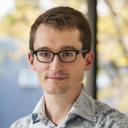
Despite the recent - and controversial - media coverage of tourist flights, space remains today, and will probably remain so for years to come, an environment that is difficult to access and hostile to human presence. The International Space Station (ISS), assembled in the early 2000s, was designed as an immense laboratory for studying phenomena impossible to reproduce on Earth, and for analyzing the impact of microgravity and exposure to cosmic radiation on living organisms. To prepare for the future of exploration, which will include new orbital stations, a sustainable return to the Moon and, eventually, the installation of man on Mars, the study of the adaptation of living organisms and the protection of astronauts are a priority for space agencies. At the same time, fundamental research continues to focus on the origin of life and the possibility of its existence elsewhere in the Universe.
.
Raising awareness among young people and inspiring vocations
Finally, the BeBlob project is in line with UNamur's vocation to disseminate science to as many people as possible. A didactic and educational component will thus accompany the experiment: Physarum polycephalum will be introduced into schools to highlight research, the human adventure experienced by the Belgian astronaut within the ISS, and to spark scientific vocations thanks to the inspiring combination between space exploration and the extraordinary properties of this organism.
.
Space mission 2026
Discover the other scientific experiments selected to be carried out on board the International Space Station (ISS) during astronaut Raphaël Liégeois's mission in 2026
A Federal Science Policy SPP project (BELSPO-Belgian Science Policy Office), with the support of the European Space Agency (ESA).
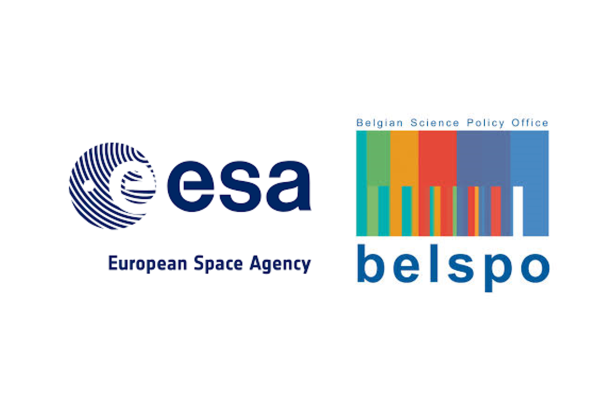
UNIVERSEH (European Space University for Earth and Humanity) is part of the "European Universities" initiative promoted by the European Commission. Its ambition is to develop a space to meet the societal, social and environmental challenges arising from European space policy.

Manipulating light to revolutionize quantum computing
Manipulating light to revolutionize quantum computing
Two researchers from the University of Namur's Department of Physics, Professor Michaël Lobet and his PhD student Adrien Debacq, are taking a close look at a subject that fascinates the scientific community : superradiance in media with a refractive index close to zero. In an article published this summer in Nature's prestigious journal Light: science & applications, in collaboration with Harvard University (USA), Michigan Technological University (MTU) and Sparrow Quantum, they contribute to the development of quantum computing.

For the past twenty years, a physical phenomenon has been attracting the attention of scientists over the world: superradiance in media with refractive indices close to zero. Among them, Michaël Lobet, professor at the Physics’ Department of UNamur, FNRS research associate and associate at the Harvard John A. Paulson School of Engineering and Applied Sciences (SEAS). “This is one of the major areas I've been studying for ten years now, and for which I was a post-doctoral fellow in Professor Eric Mazur's team at Harvard”, explains Michaël Lobet.
Superradiance, is a phenomenon that has been known for over half a century. It was theorized mathematically as early as 1954 by Robert Dicke, who showed that when elements such as atoms interact, they can synchronize to emit more powerful light. A bit like a choir singing in unison, the sound produced is much louder than each voice taken separately. But for doing this, the emitters must be very close to one another.
A index that changes everything
Scientists have discovered that one element can change everything: when the emitters are immersed in a material with a refractive index close to zero, rather than in vacuum, the position of the emitters is no longer an issue. The refractive index is a quantity that describes the behaviour of light in a material. In an ordinary material, light behaves a little like waves on the sea: it moves forward, forming crests and troughs that shift. But in a near-zero index medium, it's as if the sea becomes perfectly flat, with no waves, and starts moving up and down in a block. Everything moves in unison: the sea becomes uniform, and the wave stretches to infinity.
When the light field becomes more uniform, all the atoms find themselves optically close to each other, even if they are spatially distant. In other words, the "ambient" near-zero refractive index relaxes the strict distance between the atoms' positions, an essential condition for the entanglement of quantum particles. Quantum entanglement corresponds to correlations between particles, essential for the development of information and quantum computers.
From electrodynamics to quantum computing
This is where the promising contribution of a team of researchers from UNamur, Harvard and Michigan Technological University (MTU) comes in, supported by Dr. Larissa Vertchenko, from Danish quantum technology company Sparrow Quantum. Adrien Debacq, FNRS aspirant researcher at the Namur Institute of Structured Matter (NISM) and co-author of the paper, assisted by Harvard PhD student Olivia Mello and Dr Larissa Vertchenko, have together theoretically developed a photonic chip capable of radically improving the range of entanglement between transmitters, up to 17 times greater than in a vacuum. The emitters were made from nitrogen vacancy (NV) diamonds, structures well known in quantum optics.

This is the first time that such a long range has been achieved using a compact system that can be easily implemented in photonic chips
“This paper shows how near-zero refractive index photonics can transition from classical electrodynamics to the quantum regime, since superradiance is intrinsically quantum.”, summarizes Eric Mazur, Professor at the Harvard School of Engineering and Applied Sciences, who has been at the forefront of these innovative materials for the past decade. Entanglement, another purely quantum property, enables the transfer of quantum information, a concept already raised by Einstein in the 1930s as part of his work on quantum mechanics. The present work is part of this continuation, and more generally of the “second quantum revolution”, which aims to build on the fundamental discoveries of Einstein and the other founding fathers of quantum mechanics.
Very concrete applications
This prospect confirms the nascent research in recent years to potentially revolutionary applications: more efficient lasers, more sensitive optical sensors and, above all, faster and ultra-secure telecommunication tools, thanks to quantum computers. Cybersecurity, for example, is about to be revolutionized by these discoveries, guaranteeing message security through physical laws rather than complex calculations.
Preserving the high degree of entanglement on chip over longer ranges may raise the possibility of multipartite entanglement involving many qubits useful for e.g., the construction of cluster states—important resource for universal one-way quantum computing—as well as large-area distributed quantum computing and quantum communication networks that may offer drastic increase on the computational and channel capacity.
Together with Dr. Seth Nelson, Güney has helped to study the dynamic response of the quantum system in the presence of a pump laser beam.
The challenge for future research is to transform this theoretical project, combining analytical models and numerical simulations, into concrete experimental realizations. The aim is to get a little closer to practical quantum systems, which fit into dimensions as small as the thickness of a human hair. Who knows, maybe one day we'll have a quantum computer in our pocket?
Acknowledgements
The researchers would like to thank the Department of Physics and the NISM Institute, the FNRS for funding the research mandates of Michaël Lobet and Adrien Debacq, and the PTCI technology platform, whose supercomputers made this study possible, as well as for funding in part by the United States Army Research Office under MURI grant (W911NF2420195).

Let’s Twist (Light) Again: UNamur & Stanford bend beams in photonic crystals
Let’s Twist (Light) Again: UNamur & Stanford bend beams in photonic crystals
An international team of researchers has just published an article in the prestigious journal Light: Science & Applications (LSA) from the Nature group. The teams led by Professors Michaël Lobet and Alexandre Mayer (University of Namur) collaborated with the team led by Professor Shanhui Fan, one of the leading experts in the field, from the prestigious Stanford University in California (USA). The result: an article entitled ‘Twist-Induced Beam Steering and Blazing Effects in Photonic Crystal Devices’, or the study of beam deflection by twisting in photonic crystal devices. Come on, let's twist light again at UNamur!

It all started with Nicolas Roy's trip to Stanford. Nicolas is a PhD student in the Department of Physics and a member of the NISM and NaXys Institutes. The purpose of the visit to Stanford was to develop expertise at UNamur on a new method of simulating twisted photonic crystals, recently published by the prestigious university. Following discussions during the stay at Stanford, avenues for collaboration emerged, notably that of continuing research related to one of their publications in order to try to make a device that allows the direction of the light beam to be manipulated as efficiently and compactly as possible. The gamble paid off, as the theoretical study predicts a device measuring 6 microns (the size of a hair)! What's more, it is very energy efficient. In practical terms, it could be used to track satellites, for example, without moving the transmitter or receiver, which is complicated in a photonic circuit. Another practical application is being studied for Meta, a company that wants to reduce the size of virtual reality headsets to a simple pair of glasses...
During his PhD, and based on a Stanford team publication entitled "Theory for Twisted Bilayer Photonic Crystal Slabs", Nicolas reproduced the simulation method and developed an analytical model of the numerical simulations. The use of these inexpensive simulations has made it possible to find the photonic structures most capable of deflecting light in a controlled manner. The analytical model, in turn, provides an explanation for what has been observed, and thus a better understanding of what's going on. In short, it opens up prospects for simpler fabrication of future devices.
"Computational intelligence, combining machine learning and optimization/automation by algorithms, makes it possible to save human time by performing very numerous and rapid calculations. By way of comparison, the calculations that were carried out without the use of this method developed by the Stanford research team took several days. We now have simulations lasting 1 hour. The machine learning methods I've developed now make it possible to carry them out in less than a second!"
A model, but for what?
The research teams collaborating on this study are working on twisted photonic crystals, i.e. two-dimensional materials formed, for example, from two superimposed and structured layers of silicon, and their interaction with light.
It is a bit like a sandwich made of two slices of bread that can be slid over each other.
Illustration caption: Schematic representation of the disoriented photonic device used to dynamically change the direction of light.

In designing an analytical model, Nicolas Roy also used a theory that has been known since the 1960s: lattice networks. A lattice network is a plane diffraction network with a sawtooth profile. In concrete terms, it resembles the roofs of old factories. The novelty he brought to this concept is that it allows us to understand the mechanism that controls the angle of the light beam's exit thanks to the twist between the two layers. In doing so, he identified that the system acted similarly to a lattice grating. The team, using meta-models, was able to concentrate the light in a very specific direction with 90% efficiency.
Mastering light
What is the purpose of this type of twisted structure? To control light and ultimately create systems that can slow it down or even stop it.

It's a remarkable feat for this speedster, light, which travels at over 300,000 km/s! It is the fastest speed that can be reached in the universe. Slowing it down is therefore no easy task. In this type of disoriented structure, light is trapped but its state is preserved: it is put ‘on pause’, so to speak. In practical terms, we can imagine improving the characteristics of lasers or the performance of quantum computers. One important application would be to create optical memories, which would allow light bits to be stored without being destroyed and released at will. Or at least slow them down long enough to perform the mathematical operations necessary for all-optical computing. Another application is to take advantage of the slowing down of light to enhance light-matter interactions. This can be used to increase the efficiency of chemical reactions in photocatalysis, for example. These photocatalytic reactions are useful for water treatment or air treatment, for example, subjects on which Professors Olivier Deparis and Bao-Lian Su are working at the NISM institute.
.
This twist technique therefore opens up many unexplored possibilities in photonics by adding a degree of control over light. The researchers are continuing their work in this area, continuing their fruitful collaboration with Professor Fan's team, Stanford University.
It looks like there's no end in sight to the twisting at the University of Namur!
The research teams involved
The Belgian team
- Professor Michael Lobet (UNamur, Harvard University)
- Professor Alexandre Mayer (UNamur)
- Dr Nicolas Roy (UNamur)
The American team
- Professor Shanhui Fan (Stanford University)
- Dr Beicheng Lou
Thanks
The researchers thank UNamur, and more specifically the Department of Physics and the NISM Institute for funding Nicolas Roy's trip, the Institut naXys for its support in this project, the PTCI technology platform, whose supercomputers made this study possible, as well as the FNRS for funding the research mandates of Michaël Lobet and Alexandre Mayer.

The Department of Physics welcomes a delegation from CERN
The Department of Physics welcomes a delegation from CERN
In May 2025, the Department of Physics welcomed two special visitors: Serge Mathot and François Briard from Namur, both alumni of UNamur and members of CERN. Several activities were on the program, ranging from a visit to the particle accelerator, to science popularization and thematic seminars, particularly in heritage sciences. The aim? To identify areas or activities in which UNamur and CERN could strengthen their collaboration.

In the picture, from left to right: (top) Pierre Louette, Director of the Physics Department; François Briard, Head of the Science Portal Group (CERN); Julien Colaux, IBA specialist, physics researcher; Boris Hespeels, biology researcher; Alexandre Mayer, physics researcher; Anne-Catherine Heuskin, physics and biophysics researcher. (bottom) André Füzfa, astrophysicist and mathematics researcher; Serge Mathot, Applied Physicist (CERN) and Michaël Lobet, physics researcher.
The love affair between CERN and UNamur goes back a long way. CERN's accelerator complex and experimental program are very different and much larger than those of UNamur's Physics Department, but the fields in which the two institutions work have much in common.
In addition, both guests have a personal history with UNamur. The Physics Department was pleased to welcome Serge Mathot, Referent Applied Physicist (CERN) and alumni of the UNamur Physics Department (1992), as well as François Briard, Group Leader Science Portal (CERN), and alumni of the UNamur Faculty of Computer Science (1994).
The activities began with a meeting between the guests, Rector Annick Castiaux, Vice-Rector for Research Carine Michiels, Physics Department Director Pierre Louette and several other members of the Physics and Biology Department. After a general presentation of the University, the participants pointed out the missions shared by both institutions: research and the transfer of technology and knowledge, service to society, scientific popularization and education and training.
.
Focus on meetings
Physics lunch - CERN presentation
The physics lunch is the monthly meeting between students and members of the physics department and a professional, alumni or not, coming to explain his or her background and what he or she does on a daily basis as a physicist.
During this meeting, attended by around 80 people, François Briard and Serge Mathot presented CERN, the world's largest laboratory for particle physics. CERN's mission is to understand the most elementary particles and the laws of our universe.
At the end of the seminar, the students came away with stars in their eyes. Indeed, opportunities for internships or even first jobs at CERN are possible for physicists but also in many other fields.


Your physics training at UNamur is your best ticket to a job at CERN. It's more than just a degree in particle physics!
Some internship programs at CERN are particularly well suited to the needs of young Belgian students.
The vast majority of physicists working with CERN (over 13,000) are in fact sent to CERN for varying periods of time by their employing national research institutes. CERN offers an exceptional opportunity to develop international experience under excellent conditions, in an environment that is unique in the world! What an inspiration for our young students!
Visit of the ALTAÏS and SIAM facilities
Capable of generating ion beams consisting of any stable element with energies of up to 16 Mega electron-Volt (MeV), the ALTAÏS particle accelerator is used in various fields of fundamental and applied research, notably through industrial partnerships. CERN's largest current linear accelerator can produce particle beams of up to 160 MeV.

Meeting with members of the ARC PHOENIX project, complemented by a heritage science seminar given by Serge Mathot.
The projet d'Action Recherche Concertée (ARC) PHOENIX aims to renew our understanding of medieval parchments and ancient coins. Artificial intelligence will be exploited to analyze the data generated by material characterization.
This joint study between the Department of Physics and the Namur Institute of Structured Matter (NISM) and the Department of History and the Institut Patrimoines, Transmissions, Héritages (PaTHs) will address questions relating to the production chain and use of these objects and materials in past societies.
At the same time, Serge Mathot presented a seminar in heritage science attended by some 50 people. In particular, he presented his research and the brand-new ELISA accelerator: a miniaturized gas pedal capable of delivering a 2 MeV proton beam used to perform real measurements at the Science Portal.
Meeting on science popularization
Having the opportunity to exchange views with François Briard, Group Leader of the CERN Science Portal is a rare opportunity. Comparing outreach activities has opened up new avenues, discovering and sharing approaches, assessing what works and what doesn't, depending on the target audience. A highly satisfying enrichment for the members present from Confluent des Savoirs (CDS), the University of Namur's research outreach and dissemination service.

The CERN Science Portal is a place where you can explore CERN and science through authentic and innovative experiences: immersive multimedia exhibitions, hands-on lab workshops, science shows, events combining science and culture, prototyping workshops on the theme of innovation, tours of CERN sites, all accompanied by CERN staff.
BD Physix - Energy
Teachers André Füzfa and Michaël Lobet were able to present the comic strip project created with author Jean-Marc Dubois.
The theme? Energy!
What could be more natural than to talk about it with François Briard, chief popularizer at CERN, who is interested in this popularization project in a medium accessible to people aged 7 to 77!

Meeting on the theme of biophysics
Professor Anne-Catherine Heuskin and Dr. Boris Hespeels are currently working on the BEBLOB project, a Belspo project with ESA support, as part of the UNIVERSEH (European Space University for Earth and Humanity) alliance. They are particularly interested in its astonishing ability to withstand high doses of radiation.
Anne-Catherine Heuskin also works in radiobiology. Particles are used to irradiate cancerous cells in order to destroy their genetic material and prevent them from proliferating: this is the basis of radiotherapy and proton therapy.
Meeting with FaSEF regarding teacher training opportunities.
The meeting confirmed the willingness of FaSEF and UNamur to get involved in coordinating the Belgian National Teacher Programme in French-speaking Belgium, which CERN intends to relaunch in 2026. Consideration was also given to other avenues for teacher training, such as CERN's forthcoming involvement in the "Salle des Pros", the training venue for the various players involved in teacher training at UNamur.
.A visit to TRAKK
The TRAKK is Namur's creative hub supported by 3 complementary partners in the field: BEP, KIKK, and UNamur. In addition to the venue, François Briard was able to visit the ProtoLab , which bridges the gap between ideas and industry by being a decentralized research and development hub accessible to SMEs and project leaders by offering advanced support in prototyping products or services.
Guests at CERN
François Briard - CERN Science Portal Group Leader, UNamur alumni 1994
Specialities:
- Information systems, administrative applications and databases (Oracle)
- Communications for the general public
- Visitor reception logistics
- Event organization for up to 80,000 participants.

Graduating in law and information technology management (DGTIC) in 1994 after his bachelor's and master's degrees in computer science in 1993, François Briard works at CERN, the European Organization for Nuclear Research in Geneva, the world's largest particle physics laboratory.
During his school career, which was 100% at UNamur, he was vice-president of the Régionale namuroise and student delegate during his years as a candidate in economic and social sciences, computer science option.
Thanks to the multidisciplinary training provided at UNamur, he was able to seize several opportunities to redirect his career at CERN, where he was an information systems engineer from 1994 and then, from 2014, redirected his career until he became Group Leader of the Science Portal, which is CERN's general public communications center.
Serge Mathot - Referent Applied Physicist at CERN, UNamur alumni 1992
His specialties
- Ion Beam Analysis (IBA)
- Metallurgy, vacuum brazing
- Radio-Frequency Quadrupole (RFQ) linacs, ion sources

Serge Mathot obtained his doctorate in applied sciences from UNamur in 1992, following his bachelor's degree in physical sciences in 1985.
He then carried out a post-doctorate at the Joint Research Center (EU science hub) in Geel, which aims to bring together multidisciplinary skills to develop new measurement methods and tools such as reference materials.
He perfected his expertise in physical metallurgy before joining CERN in 1995 as a Referent Applied Physicist. He has worked on numerous research projects (CLOUD, MACHINA, ELISA...) and developed numerous parts for the manufacture of CERN's gas pedals.
It's a great pleasure to meet him.CERN
CERN, the European Organization for Nuclear Research, is one of the world's largest and most prestigious scientific laboratories. Its vocation is fundamental physics, the discovery of the constituents and laws of the Universe. It uses highly complex scientific instruments to probe the ultimate constituents of matter: the fundamental particles. By studying what happens when these particles collide, physicists understand the laws of Nature.
The instruments used at CERN are particle gas pedals and detectors. Gas pedals carry beams of particles at high energies to collide with other beams or fixed targets. Detectors observe and record the results of these collisions.
Founded in 1954, CERN is located on either side of the French-Swiss border, near Geneva. It was one of the first organizations on a European scale and today has 25 member states, including Belgium.
Physics programs at UNamur
From the infinitely small to the infinitely large, from elementary particles to galaxies, are you thirsty to understand the whys and wherefores of the natural phenomena you observe? Physics answers all your questions.

UNamur and the blob on board the International Space Station with Belgian astronaut Raphaël Liegéois
UNamur and the blob on board the International Space Station with Belgian astronaut Raphaël Liegéois
The three Belgian scientific experiments selected to be carried out on board the International Space Station (ISS) during astronaut Raphaël Liégeois' mission in 2026 have just been unveiled by the Federal Science Policy Public Service (Belspo). One of them is carried by a team from UNamur for an experiment at the crossroads of biology and physics aimed at analyzing the resistance of the "blob", an atypical unicellular organism.

The three scientific experiments were selected from 29 projects for "their scientific value, technical feasibility and budgetary compatibility", states the public service of Federal Science Policy (Belspo).
Historically, Belgium has built up notable expertise and influence within the European Space Agency (ESA). Today, UNamur finds itself at the heart of an experiment that will be deployed during Belgian astronaut Raphaël Liegéois's stay aboard the ISS in 2026. The BeBlob project, conducted at the interface of biology and physics, aims to study Physarum polycephalum, commonly known as a "blob".
The amazing properties of the blob
This atypical unicellular organism, belonging to neither plants, fungi nor animals, fascinates scientists and the general public alike. "Although lacking a nervous system, the blob is capable of solving complex problems, such as finding the shortest path through a maze, and learning from its environment," explains Boris Hespeels.

Boris Hespeels is a researcher at the ILEE Institute and the Beblob project leader alongside Anne-Catherine Heuskin, a researcher at the Narilis Institute. "We're also interested in its amazing ability to dry out completely and survive extreme stresses, including the vacuum of space, extreme temperatures or even high doses of radiation causing massive DNA damage," the two Namur researchers continue.
Development of a miniaturized vessel for the blob
Building on their experience gained on previous ISS missions with other biological models, UNamur teams have developed a new miniaturized "vessel" for carrying different blob samples. In orbit, the astronaut will rehydrate the samples, which will then have to adapt to their new environment. The objectives are twofold: firstly, to assess the effects of the orbital environment on blob metabolism; secondly, to study DNA repair in samples previously irradiated on Earth by massive doses. Scientists will analyze how this organism repairs its genome in microgravity, and determine whether this process is altered by spaceflight.
Implications and potential applications
This work should make it possible to identify key players in cell protection and repair under extreme conditions. Combined with the many experiments carried out at UNamur, they could ultimately lead to the development of new molecules capable of protecting astronauts, preserving fragile biological samples or even limiting the side effects of radiotherapy by protecting patients' healthy cells.

Despite the recent - and controversial - media coverage of tourist flights, space remains today, and will probably remain so for years to come, an environment that is difficult to access and hostile to human presence. The International Space Station (ISS), assembled in the early 2000s, was designed as an immense laboratory for studying phenomena impossible to reproduce on Earth, and for analyzing the impact of microgravity and exposure to cosmic radiation on living organisms. To prepare for the future of exploration, which will include new orbital stations, a sustainable return to the Moon and, eventually, the installation of man on Mars, the study of the adaptation of living organisms and the protection of astronauts are a priority for space agencies. At the same time, fundamental research continues to focus on the origin of life and the possibility of its existence elsewhere in the Universe.
.
Raising awareness among young people and inspiring vocations
Finally, the BeBlob project is in line with UNamur's vocation to disseminate science to as many people as possible. A didactic and educational component will thus accompany the experiment: Physarum polycephalum will be introduced into schools to highlight research, the human adventure experienced by the Belgian astronaut within the ISS, and to spark scientific vocations thanks to the inspiring combination between space exploration and the extraordinary properties of this organism.
.
Space mission 2026
Discover the other scientific experiments selected to be carried out on board the International Space Station (ISS) during astronaut Raphaël Liégeois's mission in 2026
A Federal Science Policy SPP project (BELSPO-Belgian Science Policy Office), with the support of the European Space Agency (ESA).

UNIVERSEH (European Space University for Earth and Humanity) is part of the "European Universities" initiative promoted by the European Commission. Its ambition is to develop a space to meet the societal, social and environmental challenges arising from European space policy.



